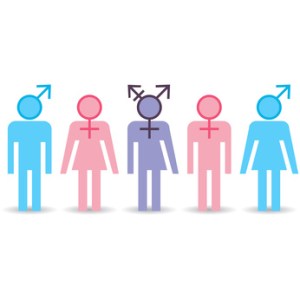By James MacDonald
There is a recurring gag in the satirical British cop show A Touch of Cloth, in which inspector Anne Oldman is forced to repeatedly remind her partner, Jack Cloth, that she is bisexual, not gay. The following is a typical exchange between the characters:
Jack: So you’re gay?
Anne: Bi, Jack.
Jack: No, don’t go. It’s none of my business.
In crafting this joke, the writers of the show have inadvertently stumbled upon a profound point about portrayals of bisexuality in the media. This simple gag is almost microcosmic, representing the prevailing ‘philistinic’ attitude towards bisexuals in the general population. It is perhaps apropos that writing an article on the erasure of bisexuality is complicated by the sheer paucity of research on the subject. Studies on attitudes towards sexual minorities have, until recently, omitted the experiences of bisexuals.
It is a curious fact about human psychology—that we tend to view issues in binary terms. Such dichotomous thinking may have adaptive advantages, and is undoubtedly useful in certain contexts, where we are forced to rely on instinct and intuition. Unfortunately, intuition is ill-equipped to parse nuance. Nowhere is this more apparent than in discussions of human sexuality, which should be dominated by many shades of grey. Our overly simplistic attitude towards sexual orientation is largely fed into by a society that emphasizes heteronormativity, monosexuality, dichotomous gender identification, and traditional values. Despite efforts to define sexuality along a continuum—most famously by Alfred Kinsey—the notion of bisexuality hasn’t really penetrated the general consciousness.
Of course, people are aware of the concept of bisexuality, but seemingly only in an abstract sense. It is perceived as a phase, something to be worked through, rather than as a concrete identity. Female bisexuals are simply being indecisive, while male bisexuals are merely taking a little longer to fully emerge from the closet.
Additionally, suppression of bisexuality can be viewed as a means of preserving monogamy as normative behavior. Intuitively, people associate monosexuality with monogamy and bisexuality with promiscuity, as though bisexuality is symptomatic of an individual wishing to copulate with the earth’s entire population! Interestingly, bisexual erasure isn’t necessarily a conscious process. There are certainly deliberate efforts to explain away and suppress bisexual behavior, but many of the examples we see on film and television are arguably not sinister attempts to render bisexuality invisible.

A prominent recent example of this can be seen on the Netflix original series Orange is the New Black, in which Piper, the central character, has her sexual orientation treated like a game of Pong, with the writers batting her sexual identity back and forth from one side to the other. Despite engaging in behaviors that could most accurately be described as “bisexual,” Piper’s sexuality is instead defined by her current partner. When she is with her husband, she is an “ex-lesbian”; when she is being intimate with a woman, she is back to simply being a “lesbian.” All the more puzzling is the fact that this takes place on a liberal show that celebrates racial and sexual diversity.
Other famously liberal feminist shows like Buffy the Vampire Slayer, Law and Order: SVU and even the boundary-breaking Ellen are similarly guilty of skirting around the issue or outright ignoring bisexuality as a legitimate sexual orientation. Again, there is no reason to think that these shows are actively engaged in a plot to erase bisexuality from general consciousness. After all, people do experiment with their sexuality and still self-identify as monosexuals. This fact complicates the issue and gives these shows something of an out. However, the more worrying problem is when individuals self-identify as bisexual and continue to have their sexual identity undermined. The Olympic diver Tom Daley recently experienced this when, in a YouTube video, he revealed that he is in a relationship with a man. Despite having previously been in a heterosexual relationship, the media’s first reaction was to label the 19-year-old as gay. Indeed, even the LGBTQ news site Pink News applied the erroneous label in their original headline reporting on the story.
Explaining this phenomenon within a religious or conservative context is fairly straightforward. However, bisexual erasure is almost a total non sequitur when placed within a secular or liberal context. How do champions of equality and diversity fulfill these roles while handicapped with such a prohibitive blind spot? Despite legal, political, and social victories for sexual diversity in recent years, it seems clear that raising consciousness on the subject of human sexuality must continue in perpetuity.
James MacDonald is a freelance writer with dual Master’s degrees in Psychology and Social Sciences, and currently lives in Hamilton, United Kingdom.
References
Herek, M.G. (2002). Heterosexuals’ Attitudes Toward Bisexual Men and Women in the United States. The Journal of Sex Research, 39(4), 1-18
Yoshino, K. (2000). The epistemic contract of bisexual erasure. Stanford Law Review, 52(2)




I would suppose that this ‘erasure’ makes sense given that there are large segments of the population that still doesn’t believe that bisexuals exist – or that they’re not supposed to. Anymore, being gay is becoming acceptable and, in the media (as in TV shows) there are a lot of gay characters (and even gay actors) and I’m thinking that they’re thinking that since bisexuality isn’t a legit sexuality, why waste time shining any light on a segment of people who don’t really exist because they’re just gay and in severe denial?